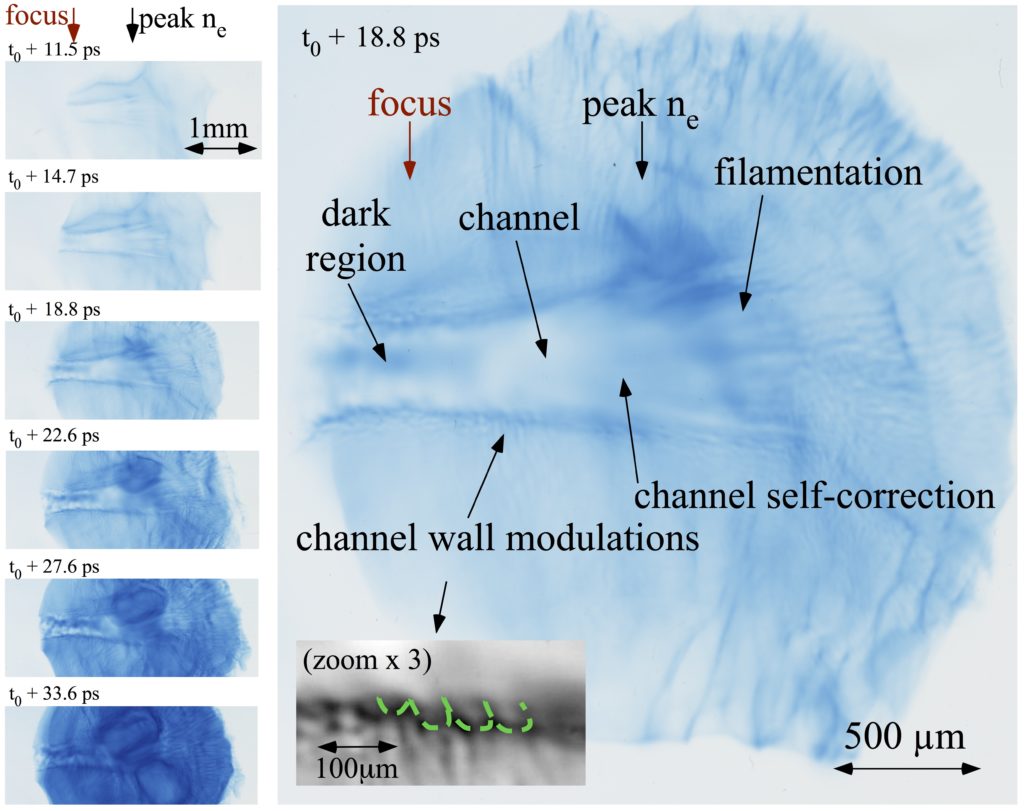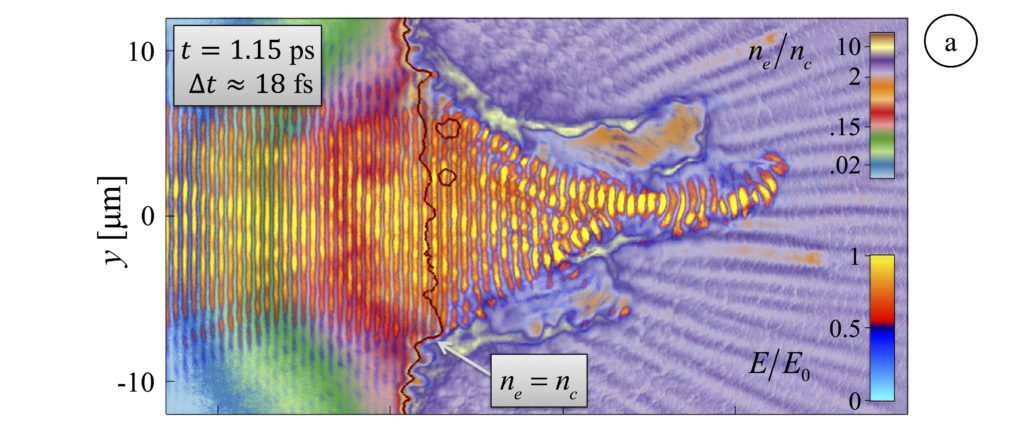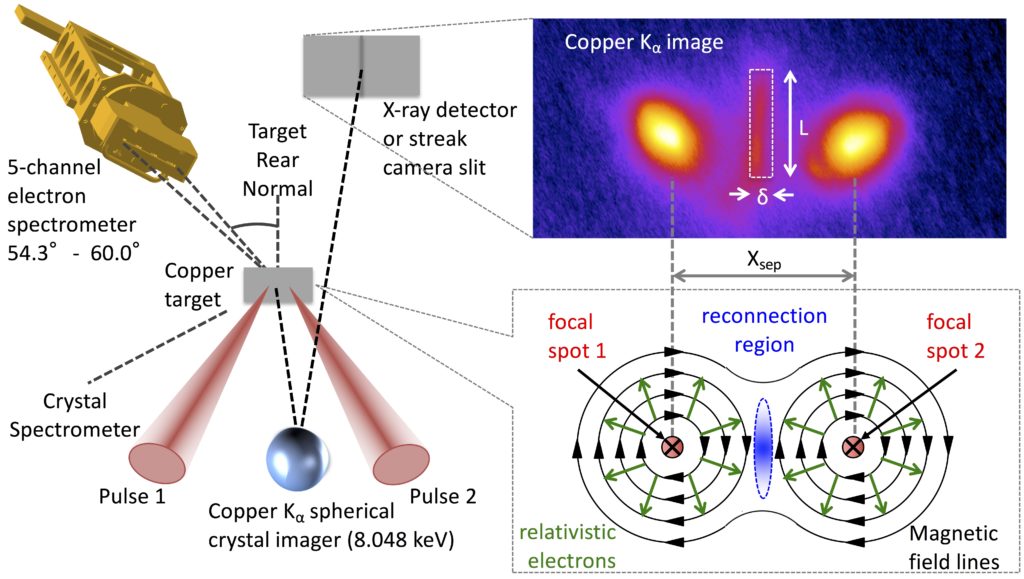An introduction to high field science
Prof. Willingale’s research is discussed in this short article.
ZEUS: Zettawatt Equivalent Ultrashort laser System
The National Science Foundation (NSF) has funded the construction of ZEUS, a 3 PW laser facility that will be available to external users. Prof. Willingale is a Co-I for this project and the Associate Director for the facility.
Laser channeling and electron heating
The dual high-power picosecond laser pulses available at the OMEGA EP facility enable proton radiography to be performed on a second relativistic intensity interaction. Proton radiography is a diagnostic that enables the measurement and imaging of quasi-static electromagnetic fields. We have used this technique to study the propagation of a high-intensity laser pulse propagating through low density plasmas. The ponderomotive force of the laser pulse expels electrons from regions of highest intensity to form a channel along the propagation path of the laser pulse. Read more in this publication.
There are strong electromagnetic fields within the channel and these can couple with the laser fields to directly accelerate electrons to very high energies (100’s of MeV). Our experiments investigate how particles interact with the fields to produce very high energy electron beams. Read more about optimizing the electron acceleration in this publication. These electron beams are potentially useful to create an extremely bright, directional, broadband, x-ray source as a backlighted for high-energy-density experiments or for designing a test for the two-photon Breit-Wheeler process.
Sequence of proton probe images (left), with a blowup of one image (right). The inset shows a region of the channel wall. The laser pulse was traveling from left to right.
Relativistically induced transparency
At relativistic intensities, electrons oscillate in the laser fields at speeds approaching the speed of light, c. The effective mass of the electrons is altered to ⟨γ⟩me, where the time averaged Lorentz factor is ⟨γ⟩ = (1+ a0/2)2 for linearly polarized light. This increase in the plasma electron temperature enables relativistically induced transparency (RIT), allowing the light (with a frequency ωL) to propagate to densities that exceed the classical critical density, nc = meε0ωL2/e2, i.e. up to ne = < ⟨γ⟩ nc. It has been demonstrated that RIT can produce some significant and intriguing effects: It affects ion acceleration from thin solid foils and near-critical density targets, high-energy electron acceleration at near-critical densities, produces an optical shuttering effect, and RIT has implications for the hole-boring fast ignition inertial confinement fusion concept. A recent study proposes RIT could serve as a diagnostic for the plasma energy, temperature and temperature anisotropy as well acting as a light polarizer. The aim is to build a clearer picture of the coupled effects of relativistically induced transparency on the propagation of light and the transfer of energy into the electron population, so that in turn the effects on the secondary processes of interest can be better understood. Read more in this publication.
Data from a particle-in-cell (PIC) simulation showing the interaction of a laser pulse with a classically overcritical density target, ne=3nc. The electric fields of the laser pulse are overlaid onto the electron density to highlight that a relativistically transparent channel has formed.
These effects are important to understand to provide an excellent foundation for future experiments in the soon-to-be-accessible QED-plasma regime with the 10 PW systems that are currently being commissioned, where peak intensities will exceed 1023 Wcm−2. In addition to the complex relativistic plasma physics, significant non-linear quantum electrodynamics effects – synchrotron γ-ray photons emitted from electrons in the laser fields and multi-photon Breit-Wheeler pair production – are expected to produce an exciting new “QED-plasma” regime to study. At these intensities, even solid aluminum would become relativistically transparent to the laser pulse and QED effects can dramatically change the expected behavior of the plasma.
Laser driven magnetic reconnection
Magnetic reconnection is a fundamental process occurring within plasmas during many high-energy-density phenomena, including in the solar corona (solar flares), in the magnetopause, during gamma-ray bursts, or around astrophysical objects such as pulsars and active galactic nuclei. Our understanding of violent high-energy astrophysical events primarily comes from secondary observations, but high-energy-density laboratory experiments provide a unique opportunity to study the physical mechanism using scaled systems. Terrestrially, magnetic reconnection is particularly relevant in fusion energy schemes, violent space weather events such as coronal mass ejections (CME) or solar flares that cause a problematic radiation storm for orbiting satellites, and communications or power systems. Better comprehension of the magnetic reconnection processes may improve our predictive and therefore preventative capabilities to prepare for such solar storms in the future.
The first demonstration of laser-driven magnetic reconnection used two high-energy, nanosecond duration laser pulses were used to heat a solid target and produce two expanding plasma plumes where azimuthal magnetic fields are self-generated due to the perpendicular temperature and density gradients. Between the two plasma plumes, opposing magnetic fields are driven together by plasma flows. We are investigating different experimental conditions, created using higher intensity laser pulses (of duration a few femtoseconds to picoseconds) focused onto a solid target heats electrons to MeV energies. In this case, the large azimuthal magnetic fields are generated as the electrons rapidly expand (~c) producing a huge, relativistic current along the target surface. We are performing experiments to characterize the collisionless magnetic reconnection regime to understand the heating occurring in the reconnection region, the reconnection timescales and to investigate the origin of plasma jets emanating from the reconnection region. Read more in this PRE and PoP.
A schematic of the experimental geometry for the laser driven magnetic reconnection experiments. A spherical crystal images x-rays from the front side of the target onto a detector. A typical copper Kα x-ray image is shown with the reconnection layer highlighted in the dashed box with of length (L) and width (δ) labeled. A physical picture of the interaction illustrates the two azimuthal magnetic fields expanding into the reconnection region where a target normal electric field accelerates the electrons into the dense target to generate the copper Kα emission in the midplane.
Laser-driven ion acceleration
The production of high-energy (10’s MeV), directional proton and ion beams with properties of small emittance, short duration and preferably narrow energy spread are of interest for many science, technology and medical applications. High-intensity lasers are able to heat electrons up to extremely high, MeV temperatures (i.e. relativistic). The motion of these hot electrons creates huge electromagnetic fields, that in turn can accelerate the heavier protons and ions. Depending on the target geometry and laser conditions different mechanisms for accelerating protons and ions can be created and explored.
Read about how the laser pulse duration affects the target normal sheath acceleration (TNSA) proton beam characteristics in this publication.
Read about how multiple ion species can affect shock ion acceleration in collisionless electrostatic shocks in this publication.
Read about characterization of scintillator detectors for laser-driven proton beam imaging in this publication.
Proton deflectometry measurement of magnetic fields
One nice application of laser-driven TNSA proton beams is to use the properties of short acceleration time, small virtual source size and laminar acceleration, for imaging quasi-static electromagnetic fields in other high-intensity laser plasma interactions. The charged protons get deflected by the electromagnetic fields and change the flux at the detector. See an example of our recent work to use proton radiography to understand magnetic field generation and its connection to double ablation fronts in this publication.



